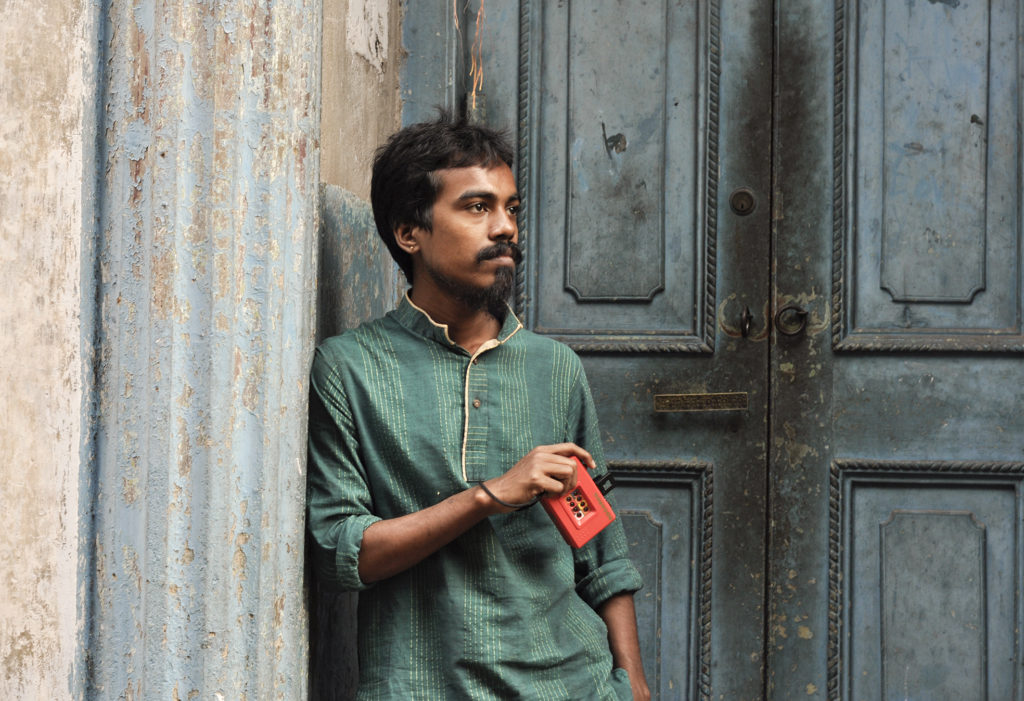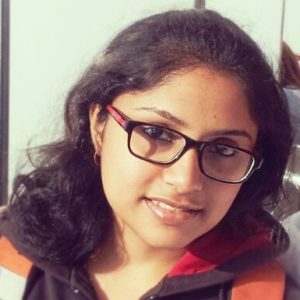Aug. 2020 Vol 01 | Issue 02
“Storytelling is the heart of
the photography”
Sankar Sarkar interview by Shraddha Ghatge

Sankar Sarkar, a Kolkata-based 30-year-old photographer, was introduced to photography under circumstances rather unconventional. In 2000, Sankar and his friends were approached by two photographers who visited his locality in Seth Bagan area of Kolkata to implement a UNICEF project, called – Empowering Sex Workers’ Children through Photography. Sankar, who was 11 years old then, was working in a paper press which made packaging boxes for sweets. He had to drop out of school as his mother could no longer afford his school fees. Having never seen or held a camera in their lives, Sankar and his friends were ecstatic when they were given a small compact analogue camera and fell in love with it the very instant. These little photographers began capturing their locality – Ganga ghat, Babu ghat and several city corners. Three years later, Sankar joined Drik India as an in-house photographer and soon was able to establish a little space for himself in the field of photography.
Sankar’s photographs were exhibited in Indian Museum, Kolkata in 2000, Chobi Mela II (Dhaka) in 2004, Delhi Photo Festival 2011, Guardian Gallery, London 2012, Angkor Photo Festival 2014, Alliance Francaise de Pondichery 2015. His work has also been acknowledged in national and international publications like The Guardian UK, Rolling Stone India, The Sunday Guardian, Livemint, Tehelka, Kindle Magazine, and so on.
Sankar’s photos of Seth Bagan, the red-light area of Kolkata where he grew up, present a vivid portrait of the locality. They include photos of his mother, his friends, his neighbors, his village; and portray their daily lives and activities; their shared laughs, innocence, and smiles – things which usually escape the judgmental eyes of society. In an honest, visceral, and unsettling account, Sankar talks to Samyak Drishti about his journey of having emerged as a photographer and storyteller from the ashes of his troubled past, and having turned into a story in himself.
Project: FACING ONE’s OWN












On his early days of photography…
My journey with photography began in 2000 when Subhendu Chatterjee and Kushal Ray visited our place to run a workshop meant to empower children of sex workers through photography. They taught us how to take pictures. We kids were really excited as we had never seen a camera before. With a camera hanging around our necks, we began roaming the city, to the Ganga ghat, Babu ghat and sometimes North Kolkata and also took pictures of our favorite place – Seth Bagan. I was initially scared of taking pictures of my area, as many a times I got shouted at by our neighbors who threatened to break the camera. It was because the women in our locality were sex workers and they didn’t like being photographed. If their relatives back home happen to see their photos by chance, it will jeopardize their relationships. However, on my mentor’s insistence, I began taking pictures of my mother who, surprisingly, was more than willing to pose for me. She would dress up in jeans, skirts, or saree and willingly tell me to take her photo. She always supported me in this endeavor.
This project went on for three years, and then I joined Drik India with the same mentors who established the branch here in Kolkata. I was 14 years old then and thus began my formal training in all things photography. I was an in-house photographer, image developer and picture library assistant, and worked on documentary films for various NGOs like Save The Children, Concern India, Anjali, British Council (Kolkata) and others.
On working with Drik India and mentors…
When I was in Drik India (it got shut down few years ago), I used to work with veterans and well-known photographers in Kolkata. They would come to our office to get their photos scanned and I would always develop their photos. I would do things like retouching, scanning, and they would always sit by my side and talk about photography, give me tips, and sometimes, even talk about their work and life in general. When you spend a whole day talking about ideas and working with such established photographers, it gives you good exposure; you learn a lot of things from them. There was this one tip that stayed with me: ‘It doesn’t matter what camera you have; it is what your eyes see that actually matters. Camera is just a tool. But as long as you have a good eye, you can make your story work in any camera.’
In these past years, many have inspired me to do good work. There were many photographers at Drik who have mentored me. I can’t simply take one or two names. However, if I have to, I have always liked veteran photographer Kushal Ray’s work. I can resonate with him as he does his work independently and quietly without much fanfare. Kushalda and I have been working together for a long time. I scanned and prepared every photograph he took, did the retouching, colour correction and so on. He gave me a lot of tips and taught me well. I’m also inspired by the Brazilian social documentary photographer Sebastião Salgado. I keep studying his work, and most of the Magnum photographers. Although I’m a school dropout, I’m visually literate and continue studying art and photography by myself and with the help of these photographers. Working with Drik India were the best days of my life.
Project: WONDERLAND












On visual literacy…
Visual literacy for me is how you read an image and make a story out of it. I learnt that while I was working with Drik India. I also interned at Drik Picture Library in Bangladesh for 8 months as a photo developer. That is where I learnt most of the important lessons on audio-visual literacy, managing a photo library and gallery work.
On work and current projects…
My projects are mostly personal as they are always connected to the people I know and places I live in. And I believe that a story holds truth and speaks honestly only when it’s told by an insider. As only an insider can do proper justice in conveying the nuances of the place he or she belongs to or the relationship he or she captures on camera.
Many photographers come up to me seeking help in photographing my neighborhood as it is difficult to get access here for an outsider. They want me to guide them and show them around, I sometimes refuse to do it because they often see us in a different light; and are unable to capture our problems or situations correctly. They always show negative side of these places which only increases the stigma to attached to it. Some pay money to a woman, take her picture, and make a story out of it even if the woman isn’t a sex worker. While some even lie about the location of photographs. So, I usually refuse to work with them or help them.
At present, I’m working on a project which captures the daily lives of the tribals and Bengali refugees in my village situated in Malkangiri district of Odisha. The Bengali refugees had to move to India post partition and settled in West Bengal, Assam, and Tripura. They were further resettled in Odisha, Madhya Pradesh and Chhattisgarh following the implementation of Dandakaranya Project by the central government in 1958. In Malkangiri, I find that the tribals and the Bengali refugees have eventually accepted and adapted to other cultures and yet maintained their own cultural identities. So, my project aims to highlight that.
Project: MALKANGIRI – A TALE OF COHERENCE
















Also, I recently discovered these old negatives lying around in some boxes. These were my old photographs which I had taken from Yashica camera when I had just begun with photography. I got them scanned and made work out of it. Some of these photos are of my friends, around the red-light area where I live. I thought this could be good work, as a memoir or a dedication. They didn’t have the opportunities which I had. I was fortunate enough to learn how to use a computer and continue with photography. Sadly, I have lost touch my friends now, as some of them left the place, some died, some got married and moved to another city. There are a few people, but we don’t have the connection we had before. But at least I have these photographs.
I’m also working on another project in Sundarbans, it is not complete yet. Because of the lockdown following the COVID-19 pandemic, all my ongoing projects have stalled. Meanwhile, in this lockdown here, my friends and I were able to raise funds and arrange ration kits for around 500 families, who were dealing with job losses, in my locality and vicinity. This was in collaboration with other non-profit organizations as well.
Project: LIVING ON THE EDGE











On difficult upbringing and how it has influenced his photography…
I lived in my village with my grandmother for the first two years of my life. At that time, I thought that my grandmother was my mother as she was raising me. I never knew my biological mother then-where she lived or what she did for a living; she never contacted us. Neither did I know who my father was. My maternal family back in the village didn’t want to keep me with them. So, my grandmother and I came to Kolkata in search of my mother. We had no clue where she lived, so we looked for her every day in different parts of the city. When we couldn’t find her, we would go back to Ganga ghat to spend the night and then start over again the next morning. Our search ended after a month when we finally found her in a place called Seth bagan, a small red-light area in Kolkata, where she was trafficked. My grandmother left me with my mother and returned to the village. Initially, when she left me with my mother, I felt betrayed, as if I was sold to a stranger. That was because, I never really knew my mother then, had never seen her for those first two years of my life. And I found it difficult to accept some stranger as my mother then. But I had to live with her as I had no choice. This, however, complicated my relationship with her.
When I was in fourth grade, I had to drop out of school because my mother could no longer afford my school fees. Besides, being known as children of sex workers, my friends and I were treated differently in school. There was this book club in school which refused distributing books to us because of who we were. They would tell us, that we don’t belong here, we don’t need to study, we should go to our place and work like other people in our social position. So, I dropped out and began working at places like tea shops and paper presses. In fact, I have also worked as a domestic help in a rich family just to support my mother as her earnings were not enough. I was working with the paper press (cutting paper to make packaging boxes for sweets) at the age of 11 when that UNICEF project happened.
With this introduction to photography, my life had opened up a new chapter. I began capturing my locality, and different corners of my city. However, as an insider, it is very difficult to photograph these people, because as I mentioned earlier, they were never willing to let me take their photographs. They would get angry, thinking it would be seen by their relatives and spoil their relationships. It would have been difficult for me to stay there had I continued. They actually live with two identities, one is that for your relatives and family in the village and the other is here, in the red light area. You are a sex worker here, but not in your village. My mother also lives that way.
Project: THE LOST DREAMS















People used to always tell my mother, that your son always takes your pictures… what if your relatives find out about your work? Then my mother used to say, “My life is already wasted, so if someone is taking my pictures, especially if it’s my son, I don’t really mind what others think about me.” This way, photography brought us closer. As I grew up, I saw how open-minded she is and doesn’t care of what others think of her.
When you grow up in a red-light area, you lose your self-confidence or the sense of identity. You want to hide the fact that you are a sex worker’s son. Initially, I was really ashamed of myself. Gradually, I realised that whatever my mother did… it was for me. Eventually, she started working in a bag manufacturing factory when I turned 18. She realised that she couldn’t go on with this work anymore and found this stable job and has been working there since. There is a little part of me which still can’t accept her as my mother and that’s the reason I haven’t called her ‘mom’ even once in my life. However, we are like friends. We call each other how friends would call each other, informally.
Learning photography under these circumstances helped me capture the depth and human side of these people. I’m a shy person, an introvert, but I transform into a confident one the moment I hold the camera in my hand. Working on personal project makes me happy, makes me confident. If it were not for photography, I wouldn’t have been here giving an interview.
Project: MEMORIES OF A BAZAAR, AFRESH!










On how a photographer should be today…
A good storyteller. Because storytelling is the heart of the photography, and a photographer should know how to tell a story with the camera. You also need to establish a connection with the people first before taking their pictures, so they would feel comfortable. If you spend enough time with them, bond with them, they will allow you to get them photographed.
On future projects…
At the moment, I cannot earn much from photography because I don’t get many opportunities. I get only a couple of assignments in a year. So, I don’t see it as a steady source of income. Nowadays, it’s also about how well-connected you are – an area where I lack skills as I do not possess sufficient academic qualifications. I did get a lot of relevant exposure, but I’m struggling to earn steady money through photography. People like my photos, they want to publish my story, but they don’t want to pay for it. Photography is more of a sustenance to me than a luxury.
Project: COVID RATION (PC Arup Sekhar Roy)







I have a good camera which I bought recently from my savings. However, it is sitting idle as the lockdown ruined my chances of going back to my village in Malkangiri to complete my ongoing project anytime soon. Life in a city is claustrophobic, it feels like I’m stuck in a cage. I would rather go back to my beautiful village, become a farmer, and lead a peaceful life. I have also bought a piece of land there.
Message to the society at large…
Although I know people are thinking progressively today, discrimination is still prevalent. I really don’t have anything else other than this impassioned plea: Please accept us as normal people. Don’t treat us like dirt.

Shraddha Ghatge
Member, Editorial TeamShraddha Ghatge is Mumbai-based independent journalist covering social, health, and civic issues. She has written for Firstpost, Newslaundry, People’s Archive of Rural India, Deccan Chronicle and Zeit.de. She has also worked with Mumbai Mirror, Firstpost, and on research projects with Tata Institute of Social Sciences, Mumbai. She has been a content writer for photo documentation on social issues in collaboration with well-known photojournalist Sudharak Olwe.

